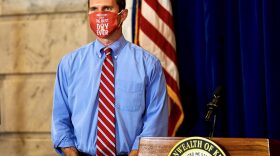More than half of Kentucky’s hospital beds are occupied and the state has not yet felt the full impact of last week’s record numbers of COVID-19.
Last week, Kentucky reported more than 9,300 new infections. Cases continued to reach new daily records over the weekend and on Monday, when the state reported 953 cases on a day when reports are ordinarily lower due to lab schedules.
Kentucky Gov. Andy Beshear blamed the state’s third surge of COVID-19 on a lack of personal responsibility, fatigue and a “culture war” over the efficacy of masks.
But even as coronavirus cases surpass heights not seen at any other time during the pandemic, Beshear refused to implement the restrictions that effectively flattened the curve during the early months, such as closing bars and restaurants.
“I’m going to level with you. If more people would follow these restrictions, we wouldn’t need to take additional steps,” Beshear said during the daily news conference Monday.
In lieu of restrictions, Beshear adopted a new list of recommendations for “red zone” counties where cases are greater than 25 per 100,000 residents.
The administration recommends all “red” counties avoid non-essential activities outside people’s homes. That means reducing shopping, cancelling gatherings of any size and working from home when possible.
These recommendations would be established on a week-to-week basis, and are supposed to be reviewed on Thursdays, Beshear said. Almost half of Kentucky’s counties were in the “red zone,” according to Monday’s report.
But as of Monday, bars, restaurants, gyms and retail shops are open to 50% capacity indoors, and gatherings up to 10 people are still allowed under Beshear’s “Healthy At Work” guidelines.
Hospital Beds
Kentucky’s hospitalizations began trending upwards even before the surge now seen around the country, escalating steadily over the past four weeks, Beshear said.
As of Monday, 63.9% of hospital beds and about 70% of the state’s intensive care unit beds were full, he said. Hospitalizations typically lag about two weeks behind new cases so it’s likely that hospitalizations will continue to trend upwards following last week’s record numbers.
“Folks, right now if a hospital accepts you as a COVID-19 patient… you are really sick,” Beshear said. “So when you see this chart it means a lot of people are getting a lot sicker.”
At the same time, there remains plenty of ventilator capacity, hospitals have more ability than early in the pandemic to increase beds and the National Guard can reassemble a field hospital at the Kentucky State Fair Grounds should it be necessary, Beshear said.
As of Monday, hospitals had not begun cancelling elective procedures, he said.
Red County Recommendations
Kentucky’s positivity rate reached 5.84% on Monday, surpassing the figure in which Beshear said he would issue new restrictions. But Beshear and Public Health Commissioner Dr. Steven Stack made the case for why they believe that new restrictions were unnecessary.
“This is how we can get this under control and if we followed these things, those red counties, like the governor said, within one to two weeks would not be red anymore,” Stack said.
The Commonwealth was one of the first states in the country to implement a mask mandate, an 11 p.m. curfew remains in effect for bars and restaurants, employers are limited to 50% capacity, gatherings of 10 or less are restricted, and long-term care sites continue to test and restrict visitation, among other measures.
Beshear said his administration has attempted to strike a balance between restrictions and compliance.
“If you move one lever too much, you see it inversely impact the other. In other words, if you push too hard on the rules and restrictions, you get less effectiveness and people are unwilling to follow them,” Beshear.
In light of that, Beshear called for “Red Zone Reduction Recommendations.” Their effect is a more targeted version of the “healthy at home” restrictions put in place in the early days of the pandemic, though then, the governor issued executive orders laying them out.
“But if not enough people aren’t following the rules the solution isn’t just more rules. It’s that we need more people out there doing the right thing,” he said.









